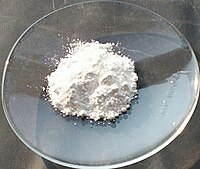
Photo from wikipedia
The on-demand release of antibacterial components due to pH variations caused by acidogenic/cariogenic bacteria is a possible design for smart antibacterial restorative materials. This study aimed to fabricate pH-responsive Zn2+-releasing… Click to show full abstract
The on-demand release of antibacterial components due to pH variations caused by acidogenic/cariogenic bacteria is a possible design for smart antibacterial restorative materials. This study aimed to fabricate pH-responsive Zn2+-releasing glass particles and evaluate their solubilities, ion-releasing characteristics, and antibacterial properties in vitro. Three kinds of silicate-based glass particles containing different molar ratios of Zn (PG-1: 25.3; PG-2: 34.6; PG-3: 42.7 mol%) were fabricated. Each particle was immersed in a pH-adjusted medium, and the solubility and concentration of the released ions were determined. To evaluate the antibacterial effect, Streptococcus mutans was cultured in the pH-adjusted medium in the presence of each particle, and the bacterial number was counted. The solubility and concentration of Zn2+ released in the medium increased with a decrease in medium pH. PG-3 with a greater content of Zn demonstrated higher concentrations of released Zn2+ compared with PG-1 and PG-2. PG-2 exhibited bactericidal effects at pH 5.1, whereas PG-3 demonstrated bactericidal effects at pH values of 5.1 and 6.1, indicating that PG-3 was effective at inhibiting S. mutans even under slightly acidic conditions. The glass particle with 42.7 mol% Zn may be useful for developing smart antibacterial restoratives that contribute to the prevention of diseases such as caries on root surfaces with lower acid resistance.
Journal Title: Molecules
Year Published: 2022
Link to full text (if available)
Share on Social Media: Sign Up to like & get
recommendations!